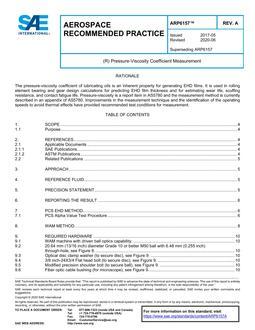No products
 View larger
View larger SAE ARP6157A
M00002070
New product
SAE ARP6157A Pressure-Viscosity Coefficient Measurement
standard by SAE International, 06/15/2020
In stock
More info
Full Description
The lubricant performance capability for aero propulsion drive systems is derived from the physical properties of the oil and performance attributes associated with the chemical properties of the oil. Physical properties, such as viscosity, pressure viscosity coefficient and full-film traction coefficient are inherent properties of the lubricating fluid. Chemical attributes are critical for the formation of protective boundary lubricating films on the surfaces to prevent wear and scuffing. These attributes are also associated with surface initiated fatigue (micropitting). To assure performance and to provide required information for engineering design, methodology for at least five oil properties are being studied: (1) pressure-viscosity coefficient, (2) full-film traction coefficient, (3) scuffing resistance, (4) wear resistance, and (5) micropitting propensity. The pressure-viscosity coefficient can be measured either directly by assessing viscosity as a function of pressure using high pressure apparatus, or indirectly by measuring film thickness in an optical interferometer. This document (ARP6157) describes the following two alternative test instruments for calculating the pressure viscosity coefficient by measuring the fluid film thickness:
i. PCS EHD2 test instrument
ii. WAM test machine
Both methods have been shown to give similar results, therefore either method can be used to calculate the pressure viscosity coefficient of a sample lubricant. For details of how to set up and run either method, see Section 7 (PCS-EHD) or Section 8 (WAM).

